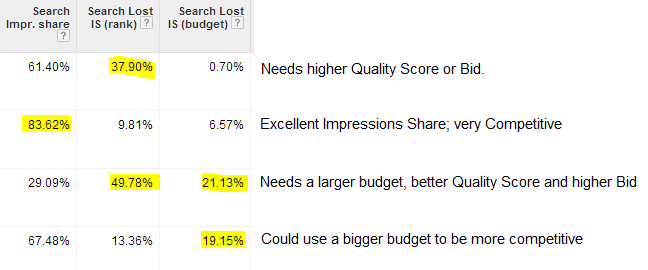Everyone knows Impressions, Clicks, Cost and Conversions. Then comes the various calculated metrics using those – Click thru Rate (CTR), Cost per Click (CPC), Conversions Rate (CR), Cost per Conversions (CPA – A is for Acquisition.) After the calculated metrics, Quality Score and Avg. Position have been shown to be very important in generating Clicks and Conversions. But since you already are familiar with those metrics, let’s look at the lesser talked about ones, which can aid you in achieve your PPC goals and objectives.
Impressions Share (IS) Metrics
- Search Impression Share
This metric reveals your competitiveness. The percentage is how often your ad is shown in comparison to how often they could have been shown. Fortunately, Google tells us exactly where and how you are losing the Impression Share battle.
- Lost Impressions Share (Rank)
While Average Position tells what ad spot your Ads are showing, this metrics tells you how often your Ads are not being shown due to low ranking. If this metric is high and you are missing several impressions, you will need to either raise your Quality Score and/or CPC bid to begin outranking your competitors.
- Lost Impressions Share (Budget)
If you are losing Impressions because your budget, then the easiest fix is to increase your budget. A high lost Impression Share (Budget) means that you are being outspent by your competitors and need to be willing to spend more to stay competitive.

Analytic Metrics
- Bounce Rate
Bounce Rate is the percentage of searchers who clicked on one of your Ads, but only viewed the Landing Page before leaving your website. This is an indicator that your Landing Pages are not guiding visitors further into your Conversion Funnel.
- Pages/Visit
This metric reveals the depth of the average visit. If your Conversion Funnel is multiple pages long, then a small Pages/Visit reveals a leak in your funnel. Shortening your Conversion funnel could be very profitable for you.
- Duration of Visit (Seconds)
While this metric does not tell you exactly what users are doing on your site, it does reveal if they are staying long enough to do anything at all. If you web page if very text heavy, but duration of visits is only a few seconds, then it is safe to say that your text is not being read. Try revising your text into bullet points and adding images. A visitors that comes through PPC cost, so you want them to stay and bring value too.
While these metrics might not tell the bottom line like the more talked about Impressions, Clicks, Conversions and Cost, they do fill in the gaps and reveal a bigger more complete picture of the success or failures of PPC Campaigns. Remember to look beyond the main metrics into the ones listed above and others that are Key Performing Indicators. These indicators will help guide you to PPC success, but you have to monitor them closely and act accordingly. Let us know if they are any other metrics that help you monitor your PPC success, or if you have any questions concerning any PPC metrics.



